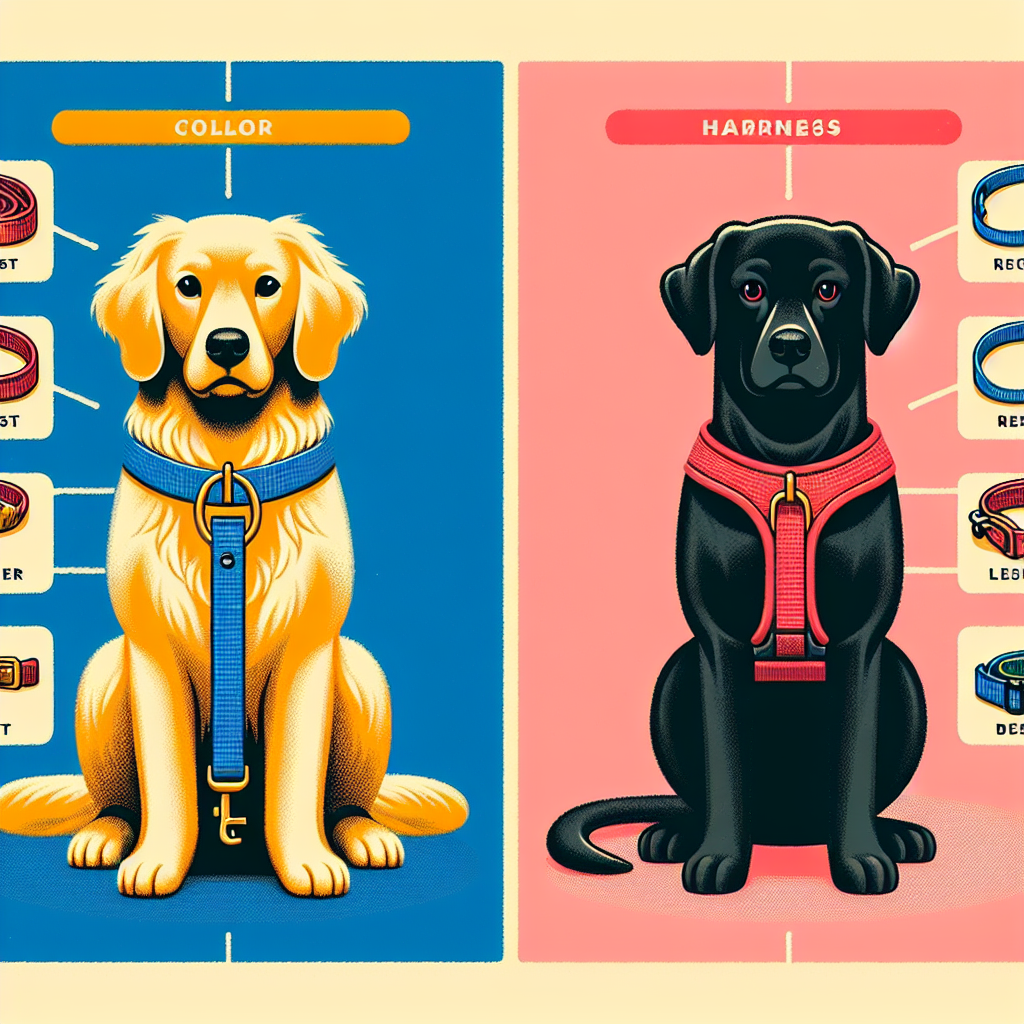Collars vs harnesses for dogs
-
Table of Contents
When it comes to choosing between collars and harnesses for dogs, pet owners often find themselves weighing the pros and cons of each option. Collars, which encircle the neck, are traditional and widely used for attaching identification tags and leashes. They come in various materials, styles, and sizes, making them a versatile choice for many dog breeds. However, collars can sometimes cause strain on a dog’s neck, especially if the dog tends to pull on the leash. On the other hand, harnesses distribute pressure more evenly across a dog’s body, reducing the risk of neck injuries and providing better control for the handler. Harnesses are particularly beneficial for dogs with respiratory issues, small breeds, or those prone to pulling. Each option has its unique advantages and potential drawbacks, making the choice largely dependent on the individual dog’s needs, behavior, and health considerations.
Benefits Of Using Collars Vs Harnesses For Dogs
When considering the benefits of using collars versus harnesses for dogs, it is essential to evaluate the specific needs and characteristics of each individual dog. Both collars and harnesses offer distinct advantages, and understanding these can help pet owners make informed decisions that promote the well-being and safety of their canine companions.
Collars are perhaps the most traditional and widely used accessory for dogs. One of the primary benefits of using a collar is its simplicity and ease of use. Collars are generally easier to put on and take off compared to harnesses, making them a convenient option for daily use. Additionally, collars provide a straightforward way to attach identification tags, which are crucial for ensuring that a lost dog can be quickly reunited with its owner. The presence of an ID tag on a collar can be a lifesaver in emergency situations.
Moreover, collars can be particularly beneficial for dogs that are well-trained and do not pull excessively on the leash. For these dogs, a collar can offer sufficient control without causing discomfort or harm. Collars also come in various styles and materials, allowing pet owners to choose one that best suits their dog’s size, breed, and personality. For instance, flat collars are suitable for most dogs, while martingale collars can be advantageous for breeds with slender necks, such as Greyhounds, as they provide a secure fit without choking.
On the other hand, harnesses offer a different set of benefits that can be particularly advantageous for certain dogs. One of the most significant advantages of using a harness is the distribution of pressure across a larger area of the dog’s body. This can be especially important for dogs that tend to pull on the leash, as it reduces the risk of injury to the neck and throat. Harnesses are designed to minimize strain on these sensitive areas, making them a safer option for dogs with respiratory issues or those prone to tracheal collapse.
Furthermore, harnesses can provide better control over the dog’s movements, which is particularly useful for training purposes. For instance, front-clip harnesses can help discourage pulling by redirecting the dog’s attention towards the owner. This can be an effective training tool for teaching dogs to walk politely on a leash. Additionally, harnesses can be more secure than collars, reducing the likelihood of a dog slipping out and escaping. This added security can be particularly reassuring for owners of escape-prone dogs or those with a high prey drive.
In addition to these benefits, harnesses can also be more comfortable for certain dogs, especially those with specific health conditions or anatomical considerations. For example, small breeds with delicate necks or dogs with short snouts, such as Pugs and Bulldogs, may find harnesses more comfortable and less restrictive. Similarly, senior dogs or those with arthritis may benefit from the added support and reduced strain that a harness provides.
In conclusion, both collars and harnesses offer unique benefits that can cater to the diverse needs of different dogs. While collars are convenient, easy to use, and suitable for well-trained dogs, harnesses provide better control, distribute pressure more evenly, and can be more comfortable for certain breeds and health conditions. Ultimately, the choice between a collar and a harness should be based on the individual dog’s behavior, health, and specific requirements, ensuring that the selected accessory promotes their safety, comfort, and overall well-being.
Safety Considerations: Collars Vs Harnesses For Dogs

When considering the safety of our canine companions, the choice between collars and harnesses is a significant decision that warrants careful consideration. Both options have their merits and potential drawbacks, and understanding these can help pet owners make an informed choice that prioritizes their dog’s well-being.
To begin with, collars are the traditional choice for many dog owners. They are simple, easy to use, and come in a variety of styles and materials. Collars are particularly effective for holding identification tags, which are crucial for the quick return of a lost pet. However, it is important to recognize that collars can pose certain risks, especially for dogs that tend to pull on the leash. When a dog pulls, the pressure exerted on the neck can lead to injuries such as tracheal collapse, neck strain, and even damage to the thyroid gland. This is particularly concerning for smaller breeds and those with pre-existing health conditions.
In contrast, harnesses distribute the force of a pull across a larger area of the dog’s body, specifically the chest and shoulders, thereby reducing the risk of injury to the neck. This makes harnesses a safer option for dogs that are prone to pulling or have respiratory issues. Additionally, harnesses provide better control over the dog, which can be particularly beneficial for training purposes and for managing larger or more energetic breeds. The design of a harness also minimizes the risk of the dog slipping out, which can be a concern with collars, especially for dogs with narrow heads or thick necks.
Despite these advantages, harnesses are not without their own set of considerations. For instance, some harnesses can be cumbersome to put on and take off, which may be inconvenient for both the dog and the owner. Moreover, if not fitted properly, a harness can cause chafing or restrict the dog’s movement, leading to discomfort or even injury. It is crucial to ensure that the harness fits well and is adjusted correctly to avoid these issues.
Another factor to consider is the specific needs and behavior of the dog. For example, dogs that are well-trained and do not pull excessively may do well with a collar, as it allows for greater freedom of movement and is generally less restrictive. On the other hand, dogs that are still in the training phase or have a tendency to pull may benefit more from the control and safety provided by a harness.
Furthermore, the choice between a collar and a harness can also depend on the activity in question. For everyday walks, a harness may be the safer and more comfortable option. However, for activities such as running or hiking, where the dog needs to move more freely, a collar might be more appropriate. It is also worth noting that some owners opt to use both, employing a collar for identification purposes and a harness for walks and other activities.
In conclusion, the decision between a collar and a harness should be based on a thorough assessment of the dog’s individual needs, behavior, and health considerations. While collars offer simplicity and ease of use, harnesses provide enhanced safety and control, particularly for dogs that pull or have respiratory issues. By carefully weighing the pros and cons of each option, pet owners can make a choice that ensures the safety and comfort of their beloved canine companions.
Training Tips: Choosing Between Collars And Harnesses For Your Dog
When it comes to training your dog, one of the most fundamental decisions you will face is choosing between a collar and a harness. This choice can significantly impact your dog’s comfort, safety, and the effectiveness of your training sessions. Understanding the advantages and disadvantages of each option is crucial for making an informed decision that best suits your dog’s needs.
Collars are the traditional choice for many dog owners and trainers. They come in various styles, including flat collars, martingale collars, and choke chains. Flat collars are the most common and are typically made of nylon or leather. They are easy to put on and take off, making them convenient for everyday use. Martingale collars, on the other hand, are designed to prevent dogs from slipping out of their collars while providing a gentle correction. Choke chains, though less popular today due to concerns about potential harm, are still used in some training scenarios.
One of the primary benefits of using a collar is its simplicity. Collars are generally less cumbersome than harnesses and can be worn continuously without causing discomfort. They also provide a convenient place to attach identification tags, which is essential for your dog’s safety. However, collars can pose risks, especially for dogs that pull on the leash or have respiratory issues. The pressure exerted on the neck can lead to injuries such as tracheal collapse or damage to the thyroid gland. Therefore, it is crucial to choose a collar that fits properly and to use it responsibly.
In contrast, harnesses distribute pressure more evenly across a dog’s body, reducing the risk of injury. They are particularly beneficial for dogs with respiratory problems, small breeds, and those prone to pulling. Harnesses come in various designs, including back-clip, front-clip, and dual-clip options. Back-clip harnesses are ideal for well-behaved dogs that do not pull, as they provide a comfortable and secure fit. Front-clip harnesses, on the other hand, are designed to discourage pulling by redirecting the dog’s attention towards the owner. Dual-clip harnesses offer the flexibility of both options, making them suitable for different training scenarios.
While harnesses offer several advantages, they are not without drawbacks. Some dogs may find harnesses restrictive or uncomfortable, especially if they are not accustomed to wearing them. Additionally, harnesses can be more challenging to put on and take off compared to collars. It is essential to choose a harness that fits well and to introduce it gradually to ensure your dog becomes comfortable with it.
When deciding between a collar and a harness, it is important to consider your dog’s specific needs and behavior. For instance, if your dog has a history of pulling or respiratory issues, a harness may be the better choice. Conversely, if your dog is well-behaved on the leash and does not have any health concerns, a collar may suffice. Consulting with a professional dog trainer or veterinarian can provide valuable insights tailored to your dog’s unique circumstances.
In conclusion, both collars and harnesses have their respective merits and limitations. The key to successful training lies in selecting the appropriate tool that aligns with your dog’s needs and ensuring its proper use. By carefully weighing the pros and cons of each option, you can make an informed decision that promotes your dog’s well-being and enhances your training efforts.






![The Dog Podcast Uncovers Startling Truths About What We Feed Our Dogs [Press Release]](https://yourhomeandgardenhub.com.au/wp-content/uploads/2024/08/dog-bowl-400x280.webp)



![The Dog Podcast Uncovers Startling Truths About What We Feed Our Dogs [Press Release] The Dog Podcast Uncovers Startling Truths About What We Feed Our Dogs [Press Release]](https://yourhomeandgardenhub.com.au/wp-content/uploads/2024/08/dog-bowl-75x60.webp)